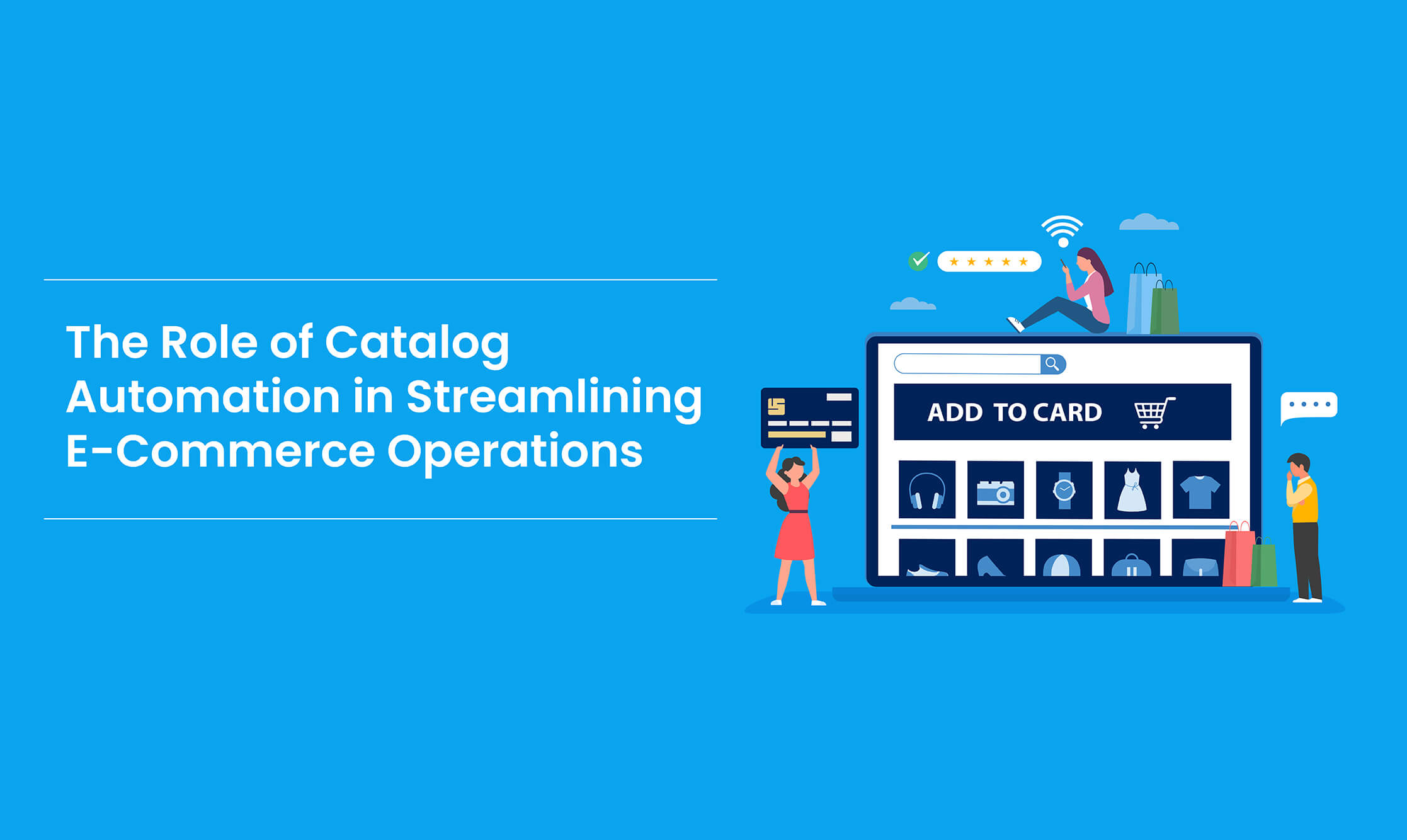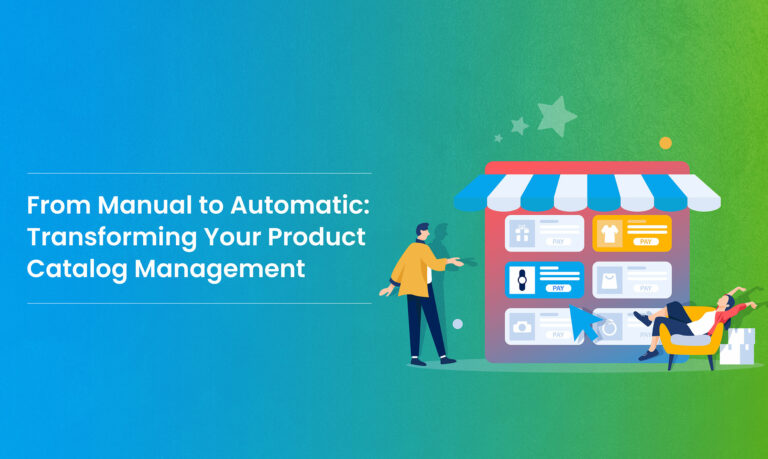Introduction
Ever wished you had a personal assistant to handle all those repetitive tasks in your online e-commerce business? That’s what ecommerce automation does for you! It’s like having a helpful robot that takes care of stuff like managing your inventory, running marketing campaigns, and updating the database without you lifting a finger. These solutions save you time, effort, and money by automating the details of data input and catalog management, allowing you to dwell on what ultimately matters—expanding your business.
In this post, we’ll look at the challenges in streamlining e-commerce business and ways to get started with catalog automation.
Understanding Catalog Automation
E-commerce product catalog management is a method of structuring and optimizing digital goods listings for a digital shop. It’s programmable software that automates laborious or repetitive processes with little or no effort on your side. You may create automated workflows for inventory management, marketing campaigns, and a variety of other processes to help your business move more smoothly.
Streamlining e-commerce business via catalog automation can free up manpower and allow you to reinvest in your organization. Automation can also provide you with useful data, allowing you to make informed decisions more rapidly.
Challenges for Product Catalog Management in E-Commerce
Managing a product catalog in e-commerce comes with its fair share of challenges. A few of them are mentioned here:
Selling across numerous channels: Any merchant that sells on several channels will agree that uploading and maintaining a catalog on various platforms at the same time is the most difficult challenge they meet. To fulfill consumer requirements and give your customers the confidence that they are purchasing exactly what they dire straits, you must offer your product with accurate and consistent information across all channels. Meeting the data standards of numerous marketplaces at the same time can be very difficult, untidy, and time-consuming.
Discrepancies in units of measurement among suppliers and systems are a typical problem that can necessitate manual intervention for changes. This mismatch can lead to mistakes and delays in catalog management procedures. Additionally, managing interaction and sharing of data with numerous stakeholders complicates the automation workflow, necessitating sophisticated systems and processes to assure correctness and uniformity in product information.
Ensuring Usability: It is critical to convert raw product data into customer-focused information. Furthermore, matching product display and segmentation to client expectations is critical for a smooth browsing experience.
Choosing the Right Catalog Management Tool: Selecting the right tool requires an awareness of its characteristics and how they integrate into your business context. For international organizations with distinct internal systems, choosing a flexible catalog management system that works across multiple countries might be difficult.
Business and catalog expansion are typically synonymous. Is your present catalog structure ready for expansion? Any irregularity or lack of coherence in your present catalog structure can pose difficulties when growing your catalog.
To help you overcome these problems, we’ve compiled the following seven best practices for managing your e-commerce inventory catalog:
Effective Techniques for Managing eCommerce Product Catalogs
To help you manage automation in your eCommerce product catalog, we’ve prepared the following seven best practices. Take a look.
Provide accurate product information to earn customer trust. When implementing eCommerce catalog management, ensure that your clients feel comfortable shopping on your eCommerce site. If you wish to meet this aim, you must include comprehensive and precise details in your product catalog. To generate high-quality product material, you can leverage these factors:
Include detailed product descriptions in your catalog. You should provide all of the information your buyers need to evaluate your services quickly. Technical specifications, images, inventory information, measurements, and product usage combinations should all be provided. This information has to be clear and easy to navigate.
Verify that all data have been revised. Helping customers make informed judgments will enhance their purchasing experience. Consider both your dynamic and static inventory data.
Use multidimensional images to showcase your products. High-quality images will attract and engage visitors to your e-commerce website. Consider employing multidimensional media files.
Tag and group products in your digital catalog. You can help your clients explore your digital product catalogs by allowing them to filter and sort the products and details in the online store. To ensure efficient eCommerce catalog management, all of your products must be consistently classified and categorized. Verify the consistency of each product tag.
Provide Comparable and Substitute Items: In a brick-motor shop, extra products are frequently placed close to the checkout counter to remind consumers of things they could have overlooked or forgotten while perusing. This tactic can raise the total sales value and promote last-minute purchases. In the same way, when buyers can’t find the specific item they’re looking for, it’s critical to recreate this experience in e-commerce by providing similar or alternative products. Through cross-selling and upselling strategies, you can improve the shopping experience and possibly increase the average order value by recommending related or similar items.
Maintain a Product Catalog Database
Since database maintenance is a type of information management, it is a crucial part of optimizing eCommerce catalog management. You may keep your product catalog database neat by using the following suggestions:
- Maintain accuracy in your product catalog. Maintaining consistency means keeping your data in a single database and not replicating it across several systems. It will also remove any errors, making it more efficient.
- Establish Role-Based Authorization: It’s critical to determine who can make changes to the product catalog database. This is particularly important when it comes to modifying the database. This aids in the understanding of duties and responsibilities for all parties concerned. Ensuring that your data remains correct and dependable also prevents duplicate entries when you have well-defined permissions.
- Consider Whether Expanding Your Database Is Viable if Your Goal Is to Expand Your Product Catalog: Think about whether your present data structure can be used to gather, arrange, and handle any data from future product catalogs. If it isn’t, you have to think about rearranging your internal data architecture to ensure scalability first.
- Choose a Robust E-Commerce Catalog Management Solution
- Selecting an eCommerce catalog management system is necessary if you want to organize your products in your web store effectively. Rubick.ai is one of the reliable options. Consider factors like your current IT setup, your company’s size, the intricacy of your catalog, the resources at your disposal, and your future expansion plans to add more online stores before making your decision. These are important considerations to make when determining which program best meets your goals, and this is where Rubick really excels.
The Bottom Line
Implementing automation is now a need for companies looking to attain simplified and scalable operations in the cutthroat world of eCommerce. With all of the factors mentioned above, eCommerce Market Automation makes it simple to streamline operations and will help you grow your eCommerce company. If you need help with eCommerce product catalog management or any other eCommerce requirement, consider collaborating with Rubick.ai to improve your digital catalog and get a competitive advantage.


